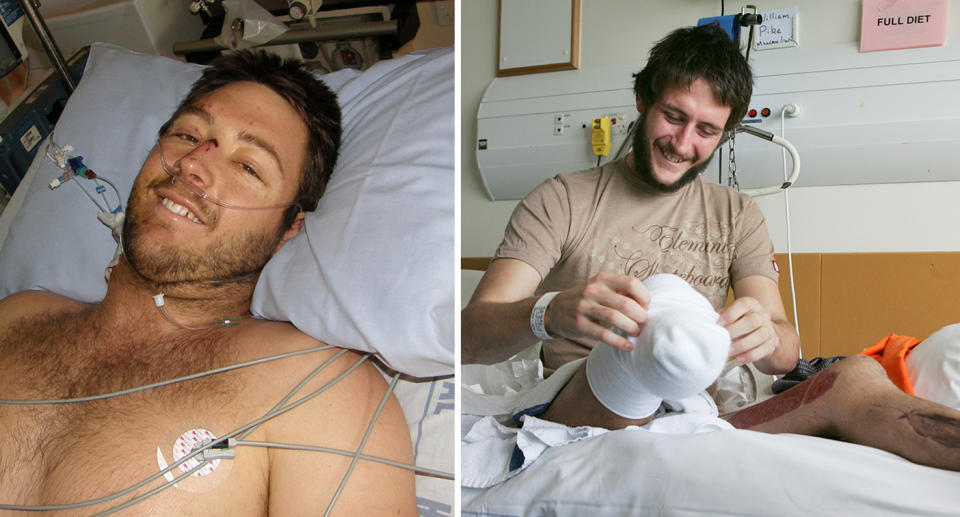'Like a jet plane taking off': What it's like surviving a NZ volcano eruption
When an active volcano on New Zealand’s White Island erupted this week, killing and injuring tourists, William Pike was sitting in Auckland, reliving some painful memories.
“It most certainly struck a chord with me… my heart goes out to those victims and their families,” he said. More than most, he knows what they have been through.
In 2007, Mr Pike had his leg amputated after a volcanic blast on the north island’s Mt Ruapehu sent earthly debris and icy water from the active volcano’s crater lake into a shelter near the summit where he and a friend were sleeping.
‘It sounded like a jet plane taking off’
The pair were enjoying a winter hike of the volcano, which also happens to serve as the largest ski field in the country.
“During that evening, at about 8 o’clock at night, Mt Ruapehu unexpectedly erupted, sending 1.5 million cubic metres of mud, rock, water, snow and ice up into the air and that came crashing down on top of the building we were in,” he recalled.
“It was fine one second, and the next second it was erupting in full force.”

Australian cruise ship passenger says she was not warned of volcano risks
'It's like Chernobyl: Witness reveals haunting details from volcano as death toll rises
Mr Pike said it was about -8C at the time. He and his hiking buddy were about 500 metres from the crater lake, the ultimate source of the eruption, when the door of the shelter blew off with tremendous force and “you could see the mountain erupting,” he told Yahoo News Australia.
“It sounded like a jet plane was taking off from the roar of the volcano.”
The eruption ended up crushing Mr Pike’s leg and pinning him under rubble and debris, forcing his friend to descend the mountain to get help.

Certain volcanic eruptions almost impossible to forecast
Mt Ruapehu and other geothermal areas on New Zealand’s North Island all have the potential to cause such events, according to Auckland volcanologist Shane Cronin.
“White Island is one of several volcanoes in New Zealand that can produce sudden explosive eruptions at any time. In this case, magma is shallow, and the heat and gases affect surface and ground water to form vigorous hydrothermal systems,” he wrote in The Conversation this week.
“We know there have been more than 60 hydrothermal eruptions in the last 100 years in New Zealand. Some of these have caused loss of life.”
Similar to the event on White Island on Monday, the eruption on Mt Ruapehu that nearly killed Mr Pike would have been almost impossible to predict.

Dr Christina Magill from Macquarie University's Department of Earth and Environmental Sciences models the risks associated with natural hazard events like volcano eruptions and says it’s not surprising that tourists didn’t have more warning from monitoring stations.
“I think that these smaller magnitude hydrothermal or phreatic eruptions (steam-blast eruptions) are always going to be very difficult to forecast,” she told Yahoo News Australia.
“Because there’s not an input of new magma, these things happen really quickly. With a larger eruption you can see the build-up to that eruption as magma comes closer to the surface, but in these smaller steam or phreatic eruptions we don’t see that and they can take us by surprise.”
Mt Ruapehu attracts thousands of skiers each snow season and hasn’t had a major eruption since 1995 and 1996 which affected more than 100,000 people in the central north island, according to the Waikato regional council.
“When you think of how many people are on Mt Ruapehu at any given time, it probably doesn’t go through their head that it could erupt,” Mr Pike said.

‘We weren’t aware of any unrest on the mountain’
In the wake of Monday’s eruption much has been made about why tourists were allowed onto White Island at the time. The Volcanic Alert Level had been increased on November 18, but there was no evidence to suggest that the volcano had moved into an eruptive phase.
Mr Pike and his friend had left maps and details of their hike with friends and had supplies to allow them to be self sufficient on the mountain for a couple of days.
“We weren’t aware of any unrest on the mountain,” he said. “It was just a level one, there was no unrest. We felt it was safe.”
Two months in hospital and 15 operations later, the former teacher now works as a motivational speaker in New Zealand, and occasionally Australia, as well as running the William Pike Challenge for school kids designed to get them outside their comfort zone and learn practical outdoor skills.

Despite his experience, he is resistant to calls for a greater clamp down on tourist activities due to fears of unpredictable natural disasters.
“Us humans are inquisitive aren’t we? With that adventure and risk comes reward. I suppose it comes down to a fine balancing act,” he told Yahoo.
“You are aware that there are inherent risks involved with visiting these places. The one thing we can’t predict is the uncertainty of Mother Nature.
“Health and safety is number one but at the same time people want to go to these places and explore and if you wrap yourself in cotton wool you certainly lose something.”
Do you have a story tip? Email: newsroomau@yahoonews.com.
You can also follow us on Facebook, Instagram and Twitter and download the Yahoo News app from the App Store or Google Play.




